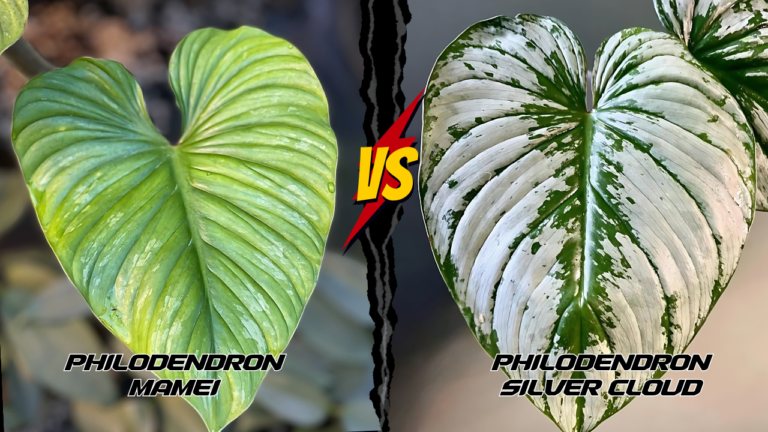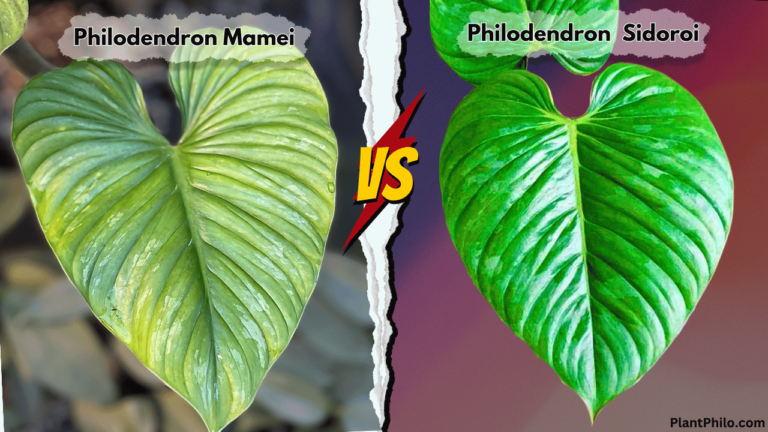Pink or Black? Your Guide to the Drama of Philodendron Black Cherry and Pink Princess
Ever wondered about the differences between Philodendron Black Cherry and Pink Princess? These stunning houseplants can be confusing, especially for beginners. Philodendron Black Cherry has deep burgundy leaves, while the Pink Princess boasts variegated green, white, and pink foliage. This guide will help you clearly identify and care for these beauties.
Both plants originate from hybrids and cultivars, making them unique in the plant world. The Black Cherry’s leaves darken with age, adding to its dramatic appearance. On the other hand, the Pink Princess is admired for its pink stems and varied leaf colors, making it a favorite among collectors.
| Feature | Philodendron Black Cherry | Philodendron Pink Princess |
| Leaf Color | Deep burgundy, darkens with age | Green, white, and pink variegation |
| Leaf Size | Larger, up to 12 inches | Smaller, slightly elongated |
| Petiole | Shorter, thicker, green/reddish | Longer, thinner, green/reddish |
| Stem | Green or slightly brown | Pinkish when young |
| Growth Rate | Slower | Faster |
| Light Preference | Tolerates low light | Needs bright, indirect light for variegation |
| Soil | Well-draining aroid mix (peat moss, perlite, orchid bark) | Well-draining aroid mix (peat moss, perlite, orchid bark) |
| Temperature | 65°F-85°F (18°C-29°C) | 65°F-85°F (18°C-29°C) |
| Humidity | Moderate to high (50-70%) | High (60-80%) |
| pH Level | 5.0-7.0 | 5.0-7.0 |
| Rarity & Price | Less rare, more affordable | Rare, more expensive |
| Other Notes | Can handle neglect better, less prone to root rot | More sensitive to overwatering and low light |
Caring for these plants is straightforward. They both prefer bright, indirect light and well-draining soil. While the Black Cherry can tolerate low light, the Pink Princess needs more light to maintain its vibrant colors. Remember to water them when the top inch of soil dries out to keep them healthy.
Key Takeaways
- Philodendron Black Cherry: Deep burgundy leaves; tolerates low light.
- Pink Princess: Variegated leaves with pink; needs more light.
- Both plants prefer bright, indirect light and well-draining soil.
Lineage and Origins
Philodendron Black Cherry and Pink Princess have unique histories that contribute to their fascinating characteristics. Learn about their respective backgrounds in these brief sections.
Philodendron Black Cherry (Hybrid)
The Philodendron Black Cherry is a hybrid plant. It belongs to the larger family of Araceae and is a variety of the popular Philodendron Erubescens. This species is native to the lush rainforests of South America.
What makes Black Cherry unique is its dark, burgundy leaves, which can darken further with age. It was developed to showcase these deep, rich colors, making it a favorite among plant enthusiasts looking for a striking addition to their collections.
Philodendron Pink Princess (Cultivar)
The Philodendron Pink Princess is a cultivar of the Philodendron Erubescens species. This cultivar is widely admired for its variegated leaves that display shades of green, white, and vivid pink. Originating from selective breeding, it’s designed to elevate the visual appeal of the traditional Philodendron.
With its pink stems and captivating variegation, the Pink Princess has become a sought-after plant for those who appreciate its unique and colorful foliage. This cultivar requires a bit more light to maintain its vibrant pink patches, unlike its Black Cherry counterpart.
Unmasking the Mystery: A Look at the Leaves
When comparing the Philodendron Black Cherry and the Pink Princess, their most distinct characteristics are found in their leaves. This includes their color, shape, and vein patterns.
Color
Philodendron Black Cherry
The leaves of the Philodendron Black Cherry are its standout feature. The foliage is a rich, deep burgundy that darkens as the plant matures, sometimes appearing almost black.
When new leaves emerge, they have a bright red tint, offering a stunning contrast against the older, darker leaves. This makes the Black Cherry a dramatic and eye-catching addition to any plant collection.
Philodendron Pink Princess
The Pink Princess Philodendron is famous for its vibrant variegated leaves. The base color is a lush green, interspersed with patches of white and various shades of pink.
The amount and distribution of the pink variegation can vary with each leaf, making each plant unique. Some leaves may show only slight pink tints, while others can be heavily splashed with pink, making it a true show-stopper.
Leaf Shape
Both Varieties
Both the Black Cherry and Pink Princess have heart-shaped leaves, which is a classic feature of many philodendrons.
Philodendron Black Cherry
The leaves of the Black Cherry tend to be larger and more uniformly heart-shaped. These leaves can grow up to 12 inches in length, making them larger than many other philodendron varieties. The pointed tip of the leaf adds to its elegant appearance.
Philodendron Pink Princess
The Pink Princess usually has slightly smaller leaves compared to the Black Cherry. While they are also heart-shaped, these leaves might be more elongated and occasionally less symmetrical. This variation in shape adds to the plant’s uniqueness.
Venation
Both Varieties
The veins on both the Black Cherry and Pink Princess are quite prominent and usually lighter in color, either a lighter green or a slight yellow hue.
Philodendron Black Cherry
With its darker foliage, the veins on the Black Cherry might not be as noticeable at first glance. However, they still provide a subtle texture and depth to the leaves. The contrast is more subdued due to the deep burgundy color.
Philodendron Pink Princess
On the Pink Princess, the veins stand out more due to the lighter variegation. The veins can sometimes appear white or yellow, adding another layer of visual interest to the already colorful leaves. This makes the plant not just a treat to grow, but also to look at.
Scrutinizing the Stems and Petioles
Both the Philodendron Black Cherry and Pink Princess feature distinctive stems and petioles that are important for plant enthusiasts to recognize.
Stems
The Philodendron Black Cherry has stems that are typically green or slightly brown. They support the vining growth habit of this plant. Sometimes, you might notice a slight variant in color in younger stems, but generally, they maintain a steady green or brown shade.
In contrast, the stems of the Pink Princess can show a bit more variation. While the primary color is similar to the Black Cherry, being green or brown, younger stems often carry a slight reddish tint. This reddish hue is a characteristic feature and adds to the plant’s visual appeal.
Petioles (Leaf Stalks)
Petioles, the stalks that attach the leaves to the stem, also differ between these two Philodendrons. For the Philodendron Black Cherry, the petioles are usually shorter and thicker. They often appear in shades of green or slightly reddish, matching the stem’s color.
In the case of the Pink Princess, the petioles tend to be longer and thinner compared to those of the Black Cherry. The colors of the petioles also reflect the stem’s shades, primarily green or slightly reddish. This subtle difference in length and thickness can help in distinguishing between the two plants.
Growth Habit and Care Requirements
Philodendron Black Cherry and Pink Princess may look different, but their care needs are quite similar. From finding the right light to knowing when to water, you can ensure these beauties thrive in your home.
Growth Pattern
Both Philodendron Black Cherry and Pink Princess are climbing aroids. They grow well when given support, such as a moss pole or trellis. Philodendron Black Cherry tends to grow a bit slower than Pink Princess. The Black Cherry’s burgundy leaves mature gradually, while the Pink Princess shows off its bright variegations as it climbs.
Philodendrons like to trail or climb, so make sure your setup allows for vertical growth. This not only keeps them healthy but also showcases their stunning foliage.
Light
Both plants thrive in bright, indirect light. Direct sunlight can scorch their leaves, so it’s important to place them where they get plenty of light but not direct rays. The Pink Princess, in particular, needs good light to maintain its pink variegation.
If you notice a fading color in your Pink Princess, it may need a brighter spot. On the other hand, the Black Cherry’s dark leaves can handle slightly lower light conditions without losing their charm.
Watering
Both Philodendrons prefer their soil to be consistently moist, but not waterlogged. Water these plants when the top inch of soil feels dry. It’s crucial to avoid letting them sit in water to prevent root rot.
Using a moisture meter can be helpful to ensure you’re not overwatering. You can also monitor their leaves – if they start to curl or yellow, they may be getting too much to drink.
Soil
A well-draining soil mix is vital for both plants. Using an aroid mix rich in organic matter works best. This typically includes a mix of peat, perlite, and bark, providing the roots with enough aeration and moisture retention.
Philodendrons don’t like dense, compacted soil. If your mix feels heavy, add more perlite or bark. This keeps the roots healthy and promotes good growth.
Additional Notes
Philodendron Black Cherry may grow a bit slower compared to the Pink Princess. The Pink Princess’s variegation can be more prominent with higher light levels. Regular feeding with a balanced, water-soluble fertilizer every 4-6 weeks can help keep their colors vibrant and growth steady.
Identification Tips for Plant Enthusiasts
To distinguish between Philodendron Black Cherry and Pink Princess, pay attention to specific features of their leaves and stems. These key points will help you identify each plant confidently.
Leaf Color
The leaf color is the most striking difference. Philodendron Black Cherry has deep burgundy leaves that darken with age. When new, the leaves may show a slight reddish tint before deepening to almost black.
In contrast, the Pink Princess Philodendron is famous for its eye-catching variegated leaves. The base color of the leaves is green, adorned with shades of pink and white. The pink stems are another distinctive feature that adds to its unique appearance.
Leaf Size and Shape
Philodendron Black Cherry tends to have larger leaves compared to Pink Princess. These leaves are usually uniformly heart-shaped, giving the plant a bold and consistent look.
The Pink Princess, while also having heart-shaped leaves, tends to have smaller and sometimes more elongated leaves. The variegation can make the leaf shape appear more irregular, adding to its charm.
Petiole Length and Thickness
Examining the petioles (leaf stalks) can also help. Philodendron Black Cherry typically has shorter and thicker petioles. This structure supports its larger leaves and adds to its robust appearance.
On the other hand, the Pink Princess usually has longer and thinner petioles. This feature helps support its somewhat smaller and lighter variegated leaves, giving the plant a more delicate look.
Light and Variegation
Philodendron Black Cherry can tolerate lower light conditions better. It prefers medium to bright indirect light but can still thrive with less light. Variegation is not a concern for this plant, as its dark leaves remain consistent.
The Pink Princess, however, requires more light to maintain its beautiful pink variegation. While it thrives in medium to bright indirect light, too little light can reduce the pink coloring. For more details on ensuring proper light, you can refer to this guide on the Pink Princess.
By focusing on these specific traits, you can easily tell Philodendron Black Cherry and Pink Princess apart. Happy plant identifying!
Frequently Asked Questions
Here, you’ll find answers to common questions about the fascinating Philodendron Black Cherry and Pink Princess varieties. These plants have unique characteristics that make them stand out in any collection.
How do you care for a Philodendron Pink Princess?
To care for a Philodendron Pink Princess, place it in bright, indirect light. Water the plant when the top inch of soil dries out. Use a well-draining soil mix and provide humidity by misting the plant or using a humidifier. Regular fertilization every 4-6 weeks with a balanced, water-soluble fertilizer is also beneficial.
What features distinguish a Philodendron Pink Princess from other varieties?
The Philodendron Pink Princess has unique variegated leaves with shades of green, white, and pink. It also features pink stems, which adds to its distinct appearance. Compared to other varieties, the Pink Princess thrives in medium to bright indirect light but is less tolerant of low light conditions.
Where can you find a Philodendron Black Cherry for sale?
You can find a Philodendron Black Cherry for sale at various online plant shops, some of which offer specific care guides to help with your purchase. Check out plant specialty sites and gardening stores for availability. One place to start looking is Plant Vault.
What are the main differences between a Pink Princess and a Marble Galaxy Philodendron?
The Pink Princess features variegated leaves with pink patches, whereas the Marble Galaxy Philodendron typically has variegated leaves with white or cream splashes instead of pink. Additionally, the Pink Princess has pink stems, while the Marble Galaxy tends to have more standard green stems.
How can I tell if my plant is a genuine Pink Princess Philodendron?
To identify a genuine Pink Princess Philodendron, look for variegated leaves with shades of green and pink patches. The plant should also have pink stems. Ensure that the pink coloration is vibrant and consistent throughout the plant’s foliage.
What should I look for when comparing the Philodendron Pink Princess to Pink Princess Galaxy?
When comparing a Philodendron Pink Princess to a Pink Princess Galaxy, observe the variegation patterns and hues. The Pink Princess will have green leaves with various shades of pink patches. In contrast, the Pink Princess Galaxy may have more varied and pronounced pink and green marbling, often with a metallic sheen.


